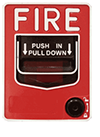Video MGMT System
 Access Control
Access Control
Voice & Data Wiring
 Burglar Alarm
Burglar Alarm
 Fire Alarm
Fire Alarm
Video MGMT System
Voice & Data Wiring
In the first part of this series, we covered the differences between fisheye cameras and multi-sensor cameras. In this guide, we’ll go over choosing a fisheye camera to suit your needs. From ensuring great image quality to what to look for to ensure a high-quality camera design, you’ll know everything you need to know about using these innovative imaging solutions to protect your home or property.
One of the first things to consider will be video quality. When looking for a fisheye lens, it’s important to remember that the megapixel rating on the camera will likely be higher than the megapixels of the video captured. This is because the shape of fisheye lenses creates a round video while camera sensors are square or rectangular. Pixel loss can reach as high as 50%. After dewarping the image, select regions of the field of view might limit megapixels further still.
For this reason, we highly recommend going to at least 5 megapixels. If you’re using it as primary camera source instead of an overview in support of additional cameras, higher megapixels will help to ensure that you can pull identifying information and convictable evidence from all corners of the feed without issues.
View some of our CCTV security camera installations in West Hartford HERE
One of the most important features for any fisheye camera is a good way of dewarping images. This helps to correct perspective and make video from your fisheye camera easier to scan. It will also help to pick out details should you need to create copies of footage after an incident. It does this by using software to account for the circular video as well as rotating portions of the video as needed to maintain proper alignment on your video monitors.
You’ll find two different types of dewarping with most fisheye camera models:
As both options are popular, many major camera makers offer models with either functionality to ensure you’ll find the perfect equipment for your needs.
Fisheye cameras come in two varieties—panomorph and full-frame. While they are interchangeable in some instances, they are not the same.
In many cases, simply attaching a panomorph camera to a tilting mount and a vertical surface will create much the same effect as a 180-degree camera. However, most 180-degree cameras are not capable of 360-degree video capture.
One last thing to consider is the framerate at which your camera captures video. While you might find cheaper models touting high megapixel capture and advanced features, many of these are doing so at the cost of framerate.
Low framerate cameras product jittery video and might even drop seconds of footage entirely. When it comes to monitoring a situation or obtaining convictable evidence, fluid, complete coverage of an event from start to finish is critical. Having exceptional coverage doesn’t mean anything if the quality of the video is subpar.
Be sure to check that framerates don’t drop below acceptable levels in low-light conditions if you plan to monitor darker areas as well. Cameras that use heavy image processing to improve images might produce great video in optimal lighting but quickly degrade in both detail and smooth movement as lights dim.
In most cases, you’ll want a framerate or frames-per-second (FPS) measurement of at least 15. However, as you near 30, the ability for the camera to capture fluid video and fast movements improves greatly.
In the last section of this fisheye camera guide, we’ll be covering the do’s and don’ts of integrating fisheye cameras into your surveillance system. You should now have a thorough understanding of the advantages of fisheye cameras and what to look for. If you’re ready to start planning your surveillance system, Mammoth Security is available 24/7 to assist! Starting the process only takes a quick phone call!
NOT COMPLETELY SURE?
860-748-4292